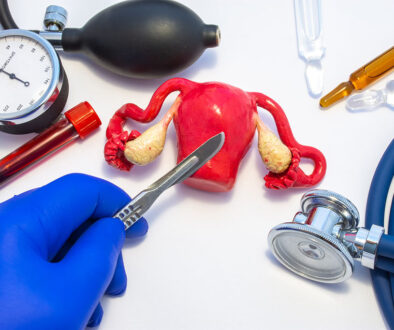Endometriosis
Endometriosis is a benign (non-cancerous) condition in which cells of the uterine lining, endometrium, is found in spots or in cysts outside the uterine cavity. The most common locations are on the surface of the ovaries, peritoneum (the membrane that lines the abdomen and pelvis), or on the intestine’s surface. It may also grow into the tissues under the peritoneum or in the areas around the rectum and vagina. It has been found, in rare instances, in distant sites such as in old episiotomy scars and even in lung tissue.
Endometriosis is estimated to occur in one out of every seven women and roughly half of the patients have no symptoms. The two most common symptoms are pelvic pain that is cyclic, occurring just before and during a menstrual period, and deep pain during sex. Endometriosis is often associated with infertility or delayed conception but most affected patients are able to have children. No one knows exactly what causes endometriosis, and it does tend to run in families. The endometriosis tissue breaks down, bleeds, and can emit inflammatory fluids into the pelvis during menses. This causes a localized inflammatory response that can cause scar tissue to form around the site of the endometriosis.
Endometriosis is often suspected by a patient presenting symptoms and a pelvic exam, but it can only be diagnosed by visualization–seeing it through a laparoscope or by a biopsy. Depending on the amount of endometriosis and scar tissue present, it is classified as minimal, mild, moderate, or severe. The extent of disease doesn’t always match symptomatology. A person with a tiny dot of endometriosis may have disabling pain, where a person with a large amount may have no pain at all. It can appear as blue to black spots, white scar tissue, red spots or pale blister-like lesions. If a piece of tissue is removed and sent to a pathologist, it will contain endometrial gland tissue and connective tissue. Occasionally, a cyst of endometriosis tissue can form within the ovary resulting in a rounded mass called an endometrioma.
Surgical removal of the endometriosis by laparoscopy or, less commonly, with an open incision is the mainstay of treatment and remains the most effective way of eradicating the process. Most people treated with surgery do experience an improvement in pain and improved fertility.
For those individuals strongly suspected of having endometriosis who want to postpone surgery, or for those patients in whom the disease could not be completely removed, an injectable medication is available called leuprolide acetate. The common name is Lupron. It causes the ovaries to stop making estrogen and progesterone temporarily, resulting in the regression of endometriosis tissue. Although irregular bleeding and hot flashing similar to menopause are common side effects, ninety percent of women will experience pain relief.
After treatment, many patients experience long term pain relief. Unfortunately, endometriosis can reoccur in as many as 30 to 40 percent of patients. Repeat courses of surgery and medication can be used. Long acting progesterone agents, birth control pills, and anti-inflammatory agents can manage symptoms.
If a patient has had ongoing problems with pain, frequent recurrence of endometriosis, or lack of response to surgery and medication and has had all the children that she desires, she may choose to have her uterus and ovaries removed. Persons who have suffered for years with recurrent symptoms often experience permanent relief with endometriosis reappearing only in rare cases.



